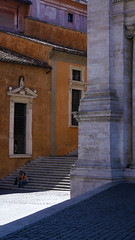One area that many new photographers find difficult is electronic flash.
Whilst many are happy to just let the camera and flash do their thing in auto mode, often the flash exposure results are not what you want.
Now the simplest solution may be just to dial in a flash exposure compensation in auto mode, but sometimes even this does not solve your problem.
A common problem is under-exposure due to the flash just not being powerful enough for the given flash to subject distance, ISO and aperture – you need to change at least one of these to get your exposure up (ie. move in closer, increase the ISO and/or open up the aperture).
My preference is to resort to manual flash exposure as this removes all computer algorithms and light metering issues from your problem solving list, BUT it does require a bit of understanding of how the flash works and just a little mathematics.
Manual flash exposure – the basics:
In manual flash mode (not just manual exposure on the camera but manual mode on the flash), the flash should pump out the same amount of light each time for a give manual output setting.
Thus for manual flash for dummies, one could just experiment with the manual output setting and adjust it until you get the results you want and/or move the flash closer or further from the subject. In fact, with the trial and error possibilities of digital photography, this is probably the easiest path to go.
But if you want to really understand it, we need to know HOW much light is being pumped out for each manual output setting.
Fortunately, this is amount is usually available by the manufacturer and given as a Guide Number (GN) at ISO 100 and in metres or feet.
To use the GN value, set your camera to ISO 100 (bad luck if you have one of those Nikon dSLRs which don’t go down to ISO 100 – you need to do some more maths!), then calculate the aperture you need to use on the lens by dividing the GN by the flash to subject distance (make sure you are using metres or feet as per the GN).
aperture to use at ISO 100 = GN at ISO 100 in metres / flash to subject distance in metres
As the intensity of light falls by the square of the distance, if you double the distance to the subject, you will reduce the light by a quarter (ie. 2 f stops wider aperture will be needed).
If you halve the flash output by setting manual mode to M/2 or half, you will need to open your aperture by 1 f stop or double your ISO to maintain the same exposure.
BUT there are problems with this manual calculation method:
- the GN is usually quoted for indoors in a “normal” room – it will give under-exposure if used outdoors with no walls to bounce light around, and it will give over-exposure if used in a small room with highly reflective walls such as bathrooms
- for macrophotography, the higher the magnification, the greater the reduction in light, thus at 1:1 macro work you need to apply a compensation factor which would require you to open the aperture by ~2 f stops
- when using attachments on the flash, it may alter the effective GN – eg. a diffuser may halve the amount of light getting to the subject
- bouncing the flash off a wall requires you to calculate the distance from flash to wall and then wall to subject, and then allow that most walls will reduce the light by ~half
- use of filters on your lens such as polarisers will require exposure compensation
- modern flashes with zoom heads will have a different maximum GN for each zoom setting
The flash meter:
To address most of these issues with manual flash (but not macro or use of lens filters), one can use an incident flash meter which is usually placed at the subject and pointing towards the incoming light and gives an aperture reading for the ISO that was set on the meter. More expensive flash meters allow one to take a reading of light hitting a subject from the position of the camera but with these spot meters, errors may be introduced by the tones of the subject.
Flash meters can be the best solution when precise exposure control is required, particularly when determining exact exposures for a main light and fill light as well as rim lights.
Setting the camera for manual flash exposure:
On most cameras it is usual to set the camera to manual mode, set the ISO and aperture according to your flash calculations, and set your shutter speed to a level dependent on how much ambient light you want to see – the slower the aperture, the brighter the ambient light will be. Remember though that you can’t use a shutter speed faster than the sync speed for your camera (usually about 1/180th sec) unless you go into FP or HSS flash mode but that’s another, more complicated story.
Remember, that for normal flash, changing the shutter speed will NOT affect the flash exposure BUT it will change the brightness of subjects lit by ambient continuous light sources.
More information on flash here.










